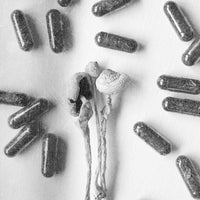Not so long ago, if you brought up the subject of psychedelic therapy in more conventional crowds, you were likely to receive a derisive snort, as if you’d just suggested that inhaling car exhaust was good for the lungs.
Cut to the present day, when testimonies to the potential mental health benefits of psychedelics are becoming nearly as commonplace as cat food commercials. Countless studies, articles, books and documentaries have called attention to the curative properties of psychedelics, especially within the context of psychedelic-assisted therapy. Oregon and Colorado have approved the use of psilocybin under the supervision of certified facilitators, and it’s likely that the U.S. will soon join Australia in green-lighting entheogens like MDMA and psilocybin as aids in mental health treatment. In short, large-scale legalization of psychedelic therapy appears inevitable.
MUD\WTR’s psychedelics advisor, Dorna Pourang, recently sat down with Imran Khan, the executive director of the U.C. Berkeley Center for the Science of Psychedelics (BCSP), to discuss the latest findings in the nascent psychedelic therapy renaissance. What follows are some of the top takeaways from their conversation, which demonstrate what’s happening on the cutting edge of psychedelic research.
Do Psychedelics Reopen the Channels of Learning?
Khan, who holds a BA in biology and a MSc in science communication, observed that for all the excitement about the promise that psychedelics hold in the mental health field, we’re still in the first stages of learning how these compounds work. This, he told Pourang, is partly because we know so little about how the brain and mind work in general.
“We take for granted that we have this thing called consciousness; that we have this amazing technicolor experience of the world around us that’s generated by a two-pound blob of jelly in our skull,” he said. “But it is just basically magic.”
In this early stage of psychedelic therapy’s growth, the scientific community is abuzz with inquiries as to what entheogens are and what they’re doing in our brains and bodies. Researchers such as Johns Hopkins neuroscientist Gül Dölen are exploring one of the most interesting aspects of this largely uncharted frontier: something called critical-period plasticity.
The idea here is that certain key points in the brain’s development present optimal opportunities for learning or relearning. For instance, it’s easier to learn a new language during childhood than during adolescence and beyond. Similarly, in the weeks or months after someone has a stroke, there’s a window of opportunity to regain function. Then, as Khan explained, that period closes and the brain can no longer learn in the same way.
Studies like this one are asking if psychedelics might reopen these critical periods. As a sign that this may be the case, Pourang mentioned that increased levels of biomolecules that support synaptic plasticity, such as brain-derived neurotrophic factor
(BDNF), have been found in research participants not only during the psychedelic experience, but also in the days and weeks after.
“That’s showing that there’s this period [during the psychedelic session] in which you have a space to build new neural connections, have new thought patterns and break undesired thought patterns—but then the time after also reinforces that,” she said.
She added that this kind of data can help people understand the importance of maintaining good habits in the weeks after a psychedelic experience.
“If you explain to them the chemical basis under which you can reinforce new patterns and habits that really change your life, that’s going to [encourage] these people to take it a lot more seriously,” she said.
Pourang and Khan also mentioned a study led by BCSP’s Andrea Gomez that explores how different genes get switched on and off in the days and weeks after a psychedelic session. The results of this research may not only shed light on the role certain genes might play in therapy and rehabilitation, but also aid in the creation of optimized compounds for therapeutic use.
Finding the Right Facilitators
Pourang and Khan both believe that if psychedelic therapy is going to be effective in helping reroute the mental, emotional and behavioral patterns of persons who suffer from conditions like PTSD and depression, the facilitators need to be well matched to the patients. For example, as Khan noted, someone who has been traumatized by incarceration or military combat isn’t likely to get meaningful support from someone who has no experience with these kinds of situations.
“That can be overcome, but it’s going to be so much easier and so much better if the population of facilitators who understand psychedelic medicine is representative of where the mental health burden is,” he said.
Pourang, who launched the veteran program for the Multidisciplinary Association for Psychedelic Studies (MAPS), pointed out that individuals who are processing wounds will generally be more motivated to help others recover from the same kinds of traumas. As an example she mentioned Jesse Gould, founder and president of Heroic Hearts, a nonprofit that helps combat veterans recover from PTSD through psychotherapy.
The Importance of Setting in Psychedelic Integration
Heroic Hearts is currently part of a groundbreaking inquiry into psilocybin’s effects on veterans with traumatic brain injuries. Whereas most trials of this kind take place in clinical settings, this program is being held at a psilocybin retreat center. This will give researchers a chance to compare the results of studies that are conducted in each of these kinds of environments.
This underscores the importance of the “setting” portion of the “set and setting” principle that has been a keystone of modern psychedelic therapy. Setting can play a critical part not just during psychedelic sessions, but in post-session integration as well. After all, as Pourang and Khan noted, it can be profoundly jarring to go back to a fluorescent-lit cubicle after having a consciousness-expanding experience in a serene, beautiful environment.
Pourang feels that to help address that issue, it’s important that there is cross-cultural research and that we integrate the wisdom of indigenous communities that have a long history of relationship and healing with psychedelics.
“Part of integrating that wisdom is giving it the same value that we give empiricism and scientific research,” she said.
Gateway Drugs
Along with bringing the potential for healing, this new era of psychedelic exploration presents a rare opportunity to gain greater insight into the elusive nature of consciousness itself.
“We have so few ways of really studying [consciousness],” Khan said. “The fact that psychedelics are now entering mainstream academia as a way to push, prod and destabilize that conscious experience in a way that allows us to try to figure out what it really is and what’s going on, I think, is potentially one of the most fascinating and exciting things that’s going to come out of this research over the coming years.”
“It’s almost like psychedelics are a gateway for us to do a lot of deep consciousness research,” Pourang mused.
Damon Orion is a writer, musician, artist, and teacher based in Santa Cruz, CA. He has written for Revolver, Guitar World, Spirituality & Health, Classic Rock, High Times and other publications. Read more of his work at damonorion.com.
Read More: The Light and Dark Side of Psychedelic Therapy
Read More: Harm Reduction for Your At-Home Psychedelic Retreat
Read More: What Is Psychedelic Integration and Why Is It Important?




